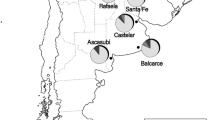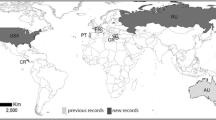Abstract
Randomly amplified polymorphic DNA (RAPD) was used to examine possible origin of Varroa jacobsoni Oudemans in the Americas. Among 64 primers screened, 2 primers provided variation which was informative for this study. All V. jacobsoni collected from the United States had the same banding pattern to that of mites collected from Russia, Morocco, Germany, Italy, Spain, and Portugal (Russian pattern). This banding pattern was different from the pattern found for mites collected from Japan, Brazil, and Puerto Rico (Japanese pattern). The Japanese pattern lacked a 766-bp band found in the Russian pattern (OPE-07). With primer OPP-03, the Russian pattern had a distinct band at 442 bp not found in the Japanese pattern. Two bands located at 675 and 412 bp were specific to the Japanese pattern. These results suggest that the V. jacobsoni of the United States is probably predominantly Russian in origin (via Europe), while the V. jacobsoni of Brazil and Puerto Rico are probably predominantly Japanese in origin.
Similar content being viewed by others
REFERENCES
Anonymous (1987). Varroa found in several states: Of mites and men (again!). APHIS caught by surprise. Glean Bee Cult 115:613.
Biasiolo, A. (1992). Lack of allozyme variability among Varroa mite populations. Exp. Appl. Acarol. 16:287.
Crane, E. (1978). The Varroa mite. Bee World 59:164.
Crane, E. (1984). Living with Varroa in Japan. Bee World 65:149.
de Guzman, L. I., and Delfinado-Baker, M. (1996). A new species of Varroa (Acari: Varroidae) associated with Apis koschevnikovi (Apidae: Hymenoptera) in Borneo. Int. J. Acarol. 22:23.
de Jong, D., and Goncalves, L. S. (1981). The Varroa problem in Brazil. Am. Bee J. 121:186.
de Jong, D., Morse, R. A., and Eickwort, G. C. (1982). Mite pests of honey bees. Annu. Rev. Entomol. 27:229.
Delfinado-Baker, M. (1988). Variability and biotypes of Varroa jacobsoni Oudemans. Am. Bee J. 128:567.
Delfinado-Baker, M., and Aggarwal, K. (1987). A new Varroa (Acari: Varroidae) from the nest of Apis cerana (Apidae). Int. J. Acarol. 13:233.
Delfinado-Baker, M., and Houck, M. A. (1989). Geographic application of multivariate morphometric techniques. Apidologie 20:345.
Griffiths, D. A., Gary, J., and Peagazzano, F. (1983). Varroa—The acarologists' view. In Cavalloro, R. (ed.), Varroa jacobsoni Oud. affecting honey bees: Present status and needs. Proceedings, EC Experts' Group Meeting, Wageningen, pp. 79–83.
Grobov, O. F., Pulenetz, N. M., and Sofronov, G. L. (1980). Geographical variability of the sizes of the dorsal scutellum in females of Varroa jacobsoni Oud. In Harnaj, V. (ed.), Proceedings of the XXVIIth International Beekeeping Congress, Athens, Bucharest, Romania, pp. 346–350.
Issa, M. R. C. (1989). Enzyme patterns in Varroa and Apis from Brazil and Germany. Apidologie 20:506.
Kraus, B., and Hunt, G. (1995). Differentiation of Varroa jacobsoni Oud. populations by random amplification of polymorphic DNA (RAPD). Apidologie 26:283.
Maniatis, T., Fritsch, E. F., and Sambrook, J. (1982). Molecular Cloning: A Laboratory Manual, Cold Spring Harbor Laboratory, Cold Spring Harbor, NY.
Moretto, G., Goncalves, L. S., de Jong, D., and Bichuette, M. Z. (1991). The effects of climate and bee race on Varroa jacobsoni Oud. infestations in Brazil. Apidologie 22:197.
Nation, J. L., Sanford, M. T., and Milne, K. (1992). Cuticular hydrocarbons from Varroa jacobsoni. Exp. Appl. Acarol. 16:331.
Oudemans, A. C. (1904). On a new genus and species of parasitic Acari. Notes Leyden Mus. 24:216.
Rosenkranz, P., Issa, M., Rachinsky, A., Strambi, A., and Strambi, C. (1989). Honeybee-Varroa relationships: A comparison of africanized and carniolan colonies. In Cavalloro, R. (ed.), Present Status of Varroatosis in Europe and Progress in the Varroa Mite Control, Proceedings, EC Experts' Group Meeting, Udine, 1988, Luxembourg, pp. 193–198.
Rowe, D. J., Rinderer, T. E., Stelzer, J. A., Oldroyd, B. P., and Crozier, R. H. (1997). Seven polymorphic microsatellite loci in honey bees (Apis mellifera). Insectes Sociaux 44:85.
Ruttner, F. (1983). Varroatosis in honey bees: Extent of infestation and effects. In Cavalloro, R. (ed.), Proceedings, Meeting of the EC Expert Group, Wageningen, pp. 7–11.
Ruttner,F.,and Ritter,W.(1980).Das Eindringen von Varroa jacobsoni nach europa im Ruckblick.Adiz 5:130.
Sakai,T.,and Okada,I.(1973).The present beekeeping in Japan.Glean Bee Cull 101:356.
Author information
Authors and Affiliations
Rights and permissions
About this article
Cite this article
de Guzman, L.I., Rinderer, T.E. & Stelzer, J.A. DNA Evidence of the Origin of Varroa jacobsoni Oudemans in the Americas. Biochem Genet 35, 327–335 (1997). https://doi.org/10.1023/A:1021821821728
Issue Date:
DOI: https://doi.org/10.1023/A:1021821821728




